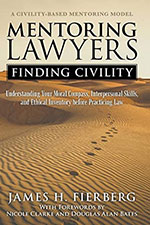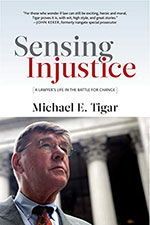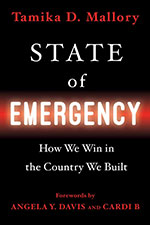 VERDICT: It’s a Keeper
VERDICT: It’s a Keeper
Mentoring Lawyers: Finding Civility
By James H. Fierberg (Bloomington, IN: Archway Publishing, 2019). 237 pgs. $18.99. Order, www.amazon.com.
Reviewed by Julie K. Brown
Embracing the need for enhanced civility in the legal profession, attorney James H. Fierberg provides thought-provoking observations, opinions, and ideas to address the ever-increasing professional and societal phenomenon of incivility and intolerance. Through recognition that law schools, by and large, are ill-equipped to provide students with the interpersonal “tools” to skillfully navigate the often arduous and conflict-ridden legal terrain, Fierberg has written this book in an effort to provide practical engagement skills for new lawyers, as well as experienced lawyers.
Recognizing the personal and institutional harm that incivility brings to the legal profession and to legal communities, Fierberg, with 40 years’ law practice experience, takes the position that the legal profession can embrace the problem of professional incivility and toxicity by encouraging law firms to establish in-house mentoring programs for new lawyers to promote cordiality and respect for opponents, colleagues, and clients in their work and in their personal lives. The gist of the book is that it is vital to live and work with a strong moral compass guiding our thoughts and actions.
Fierberg contends that by engaging in skilled and mindful individual mentoring that focuses on ethics, reputation, recognition of personal biases, and collaborative skill building, the results will be “win-win” for all involved, particularly clients. By promoting a professional development model that helps to develop reputations for honesty, reliability, dependability, and civility, the author rejects the oft-embraced model that aims to build ego, hubris, caginess, and incivility with the goal of prevailing at any cost.
Want to Review a Book?
Please request a book and writing guidelines from Wisconsin Lawyer managing editor Karlé Lester, at klester@wisbar.org or (608) 250-6127. Reviewers may keep the book reviewed. Reviews of about 500 words are due within 45 days of receiving the book. Reviews are published, space permitting, in the order received and may be edited for length and clarity.
I agreed with the author’s major premises and was motivated to engage in independent research about high-conflict personalities (which Fierberg notes is a trait sometimes found in clients and opposing counsel) and effective communication methods for dealing with contentious people. However, I found myself questioning whether Fierberg’s proposal for individual mentoring within law practices is expansive enough to address the problem of incivility and whether the more experienced attorney-mentors would engage in mindful mentoring, as opposed to promoting unrecognized personal and professional biases.
It is argued that our society today is more divisive than it has been in recent history and, as Fierberg notes, these social dynamics bleed into our professional and personal lives. Fierberg suggests that bar associations can serve as resources for promoting civility. In light of the increased acuity of current social and professional incivility and intolerance that have occurred since this book was published in 2019, it seems that bar associations may need to step up and play a larger role in ameliorating the problem – such as requiring attendance at seminars designed to address interpersonal legal skills or providing mentorship training to assist law firms in the mentoring programs advocated by Fierberg.
I particularly enjoyed the way the author started each chapter with a quote, an anecdote, or book- or movie-dialog excerpts. At times, the author’s writing style seemed repetitive, but in the end it was worth the effort in wading through the occasional weeds. It is clear that Fierberg holds the legal profession in high esteem and wants the best for those who enter the practice of law. Indeed, he posits that many lawyers who have stopped practicing might not have done so if there had been more civility and cordiality within the profession.
It is equally clear that he is heavy-hearted at the deterioration of honor and civility among lawyers – much of which he points out is promulgated and encouraged by television shows about attorneys, negative social media, and public displays of incivility by attorneys and other individuals. That said, Fierberg’s hope and optimism for the future of the legal profession is contagious, leaving the reader with motivation to be self-reflective, observant, and striving to spread civility wherever and whenever possible.
Julie K. Brown, U.W. 1988, formerly of Milwaukee (Davis & Kuel-thau SC, followed by a solo family law practice), currently lives in Bloomington, Ind., where she works for the IU Health healthcare system. jbrown2@iuhealth.org.
 VERDICT: Touchdown!
VERDICT: Touchdown!
Sensing Injustice: A Lawyer’s Life in the Battle for Change
By Michael E. Tigar (Monthly Review Press, 2021). 512 pgs. $27.99. Order, www.amazon.com.
Reviewed by Kurt C. Kobelt
Michael Tigar successfully argued the first of his seven U.S. Supreme Court cases at age 26, served as chair of the ABA Litigation Section, and has written or coauthored 13 books with such titles as Examining Witnesses and Persuasion, the Litigator’s Art.
But this is not the boasting of a Big Law defender of corporate interests. It is a memoir by someone who was redbaited out of a U.S. Supreme Court clerkship with Justice Brennan because of his activism against the Vietnam War. The first U.S. Supreme Court case he argued resulted in the release of thousands of draft resisters who were jailed for burning their draft cards. He went on to have a stellar career on the front lines of cutting-edge legal battles. In 1999, Tigar was voted the third most important lawyer of the 20th century behind Clarence Darrow and Thurgood Marshall.
Afraid of becoming a “well-to-do and skilled, but irrelevant, lawyer,” Tigar has taken on issues he could embrace with “passion,” such as free speech, government surveillance, the death penalty, and international human rights. His diverse clients included Angela Davis, the Chicago 7, Republican Texas governor John Connally, the Washington Post, Oklahoma City bomber Terry Nichols, and John Demjanjuk, who was tried and convicted after being misidentified as “Ivan the Terrible,” a guard at the Treblinka extermination camp during World War II.
When one white-collar corporate executive he represented asked Tigar why he represented Angela Davis, Tigar replied that they were both victims of governmental overreach and that, “She was an underdog. I represent a lot of underdogs pro bono. I make it up by charging market rates to the overdogs. That’s you.”
Tigar is a master storyteller, and his entertaining legal anecdotes are brimming with practical insights about trial tactics any attorney will find useful.
Tigar’s career vividly illustrates what every lawyer who challenges the powers that be knows – if you are going to win, you must prove yourself to be a better lawyer.
Kurt C. Kobelt, George Washington 1980, is a union labor attorney in Madison. He clerked for Michael E. Tigar while a law student in 1979. kurtkobelt@gmail.com
 VERDICT: It’s a Keeper
VERDICT: It’s a Keeper
Fat Chance: Diet Mania, Greed, and the Infamous Fen-Phen Swindle
By Rick Christman (Lexington, KY: Univ. Press of Kentucky, 2021). 244 pgs. $24.95. Order, www.kentuckypress.com.
Reviewed by Irwin Kass
This book is a keeper. I look forward to the movie or mini-series.
How could tiny diet pills cause so much havoc? The author, Rick Christman, entertains us with a true story that is so far-fetched that you think it must be fiction. There were secret deals, double-dealing, and back stabbing among a group of greedy lawyers who had hoped to use the health risks posed by these pills to become filthy rich. In the early 1990s, American Home Products (AHP) sold fen-phen and Redux, drugs to fight obesity. However, independent studies showed that they might damage the heart. In 1997, AHP pulled them from the market but only after being suspected of knowing about this danger earlier than the studies.
Three lawyers, Bill Gallion, Shirley Cunningham, and Melbourne Mills [hereinafter GCM], sought to cash in by filing a class action in Kentucky against AHP, Guard v. AHP.
There was also a national class action to consolidate thousands of similar lawsuits, Brown v. AHP. A fourth lawyer, Stan Chesley, sometimes called the Prince of Torts, participated in both class actions. He was well regarded after several prior high-profile mass-tort settlements.
In 2001, Guard v. AHP, with 431 plaintiffs, settled. Judge Bamberger approved the settlement and, more significantly, outrageously high attorney fees for GCM and Chesley without notifying the plaintiffs of all of the details of either the settlement or the amount of fees. The judge later retired and was paid a monthly stipend from the settlement. Thereafter, GCM lived the good life for a while by spending on real estate, cars, trips, and even a racehorse named Curlin. Eventually, suspicions of misconduct led to an investigation and then indictments.
You will be shocked to read about the shenanigans used by GCM and Chesley in the heist and then trying to cover their tracks. For instance, there was evidence of collusion between Chesley and AHP lawyers, using personal secrets to unduly influence Judge Bamberger, undisclosed side agreements, lying to clients, a slush fund, and secret accounts. Additionally, files were destroyed or hidden in a cave to thwart the FBI. Bribes were paid. Other lawyers or staff were used to move or hide money or evidence.
In 2009, Gallion and Cunningham were convicted in a second trial and given lengthy prison sentences and stiff fines for stealing clients’ money. The first trial ended in a hung jury for Gallion and Cunningham; Mills was found not guilty, presumably because of evidence regarding his alcohol abuse. Chesley had gained immunity to testify against GCM. GCM, Chesley, and Judge Bamberger were disbarred, and substantial civil money judgments were entered against them. Some of the others who became involved either were granted immunity to testify or were also convicted and sentenced for related crimes.
It did not end well for GCM, Chesley, or anyone in their sphere. The only bright spot was that after a successful racing career, Curlin finally had time to enjoy the good life as a stud horse.
Irwin Kass, Chicago-Kent 1976, is retired after practicing law in Madison.
 VERDICT: For Me, Maybe Not for You
VERDICT: For Me, Maybe Not for You
State of Emergency: How We Win the Country We Built
By Tamika D. Mallory as told to Ashley A. Coleman (New York, NY: Atria/Black Privilege Publishing, 2021). 227 pgs. $19.96 Order, www.amazon.com.
Reviewed by Dianne Post
This combination of personal memoir and political manifesto is divided into three parts: how we got here, where we are, and where we are going. Readers’ relationship to the book might coincide with their experience in, knowledge of, and involvement with the Black struggle. It is useful to understand some history, reality, and feelings of Blacks. It does leave out a lot of history, appropriates ideas without attribution (Mallory herself might not know these concepts and sayings are from a much earlier time), and necessarily skims over some of the breadth and depth of the history of the United States.
The writing itself is amateurish and scattered in places, and the “where we are” section misses some important history, but the book is intended to spark action, not rumination. The well-publicized problem at the Women’s March, no doubt very painful as Mallory admits, is glossed over too lightly, possibly leaving readers with questions.
The most important section is “where we are going” because the main point is to do something. The “defund the police” mantra echoes the recommendations of the Kerner Commission from 1968. Unfortunately, those recommendations were shelved, and the United States lost yet another opportunity to right this ship. Law is not the only answer – we need investment in communities.
Mallory’s suggestions include protests, voting, allyship, decentralized and centralized organizing, boycotts, buy Black initiatives, and donations and investments. Protest, politics, and policy all must be focused on criminal and economic justice, education, and reparations. Mallory speaks about accountability, public safety, and white supremacy. In the book and in her speech of the same name, Mallory reminds readers that whites started the looting and violence aimed at Native and enslaved peoples. Keep this in mind if you see burning buildings in a news clip and shake your head.
The time is well past for us to fix this bleeding wound in the U.S. psyche. We have been here before – Reconstruction, the civil rights movement of the 1950s, Emmett Till, Rodney King, to name a few – and here we are again. If Americans want to move forward as we must, demographics will eclipse us in 20 years. We need a truth-and-reconciliation type structure in which we admit not just the mistakes but the ongoing ramifications. In some other countries, Germany and Cambodia for example, horrors (Hitler, Pol Pot) have been acknowledged and actions taken to prevent the horrors from happening again. In the United States, many people still lionize the villains.
It was very painful to see Wisconsin and Minnesota named as the “new south” for their terrible records on the treatment of Blacks. Lawyers are sworn to uphold justice, so lawyers need to step up and be among the useful allies.
Dianne Post, U.W. 1979, practiced family law for 18 years in Arizona, mostly representing battered women and molested children, before she switched to international human rights law in 1998. postdlpost@aol.com
